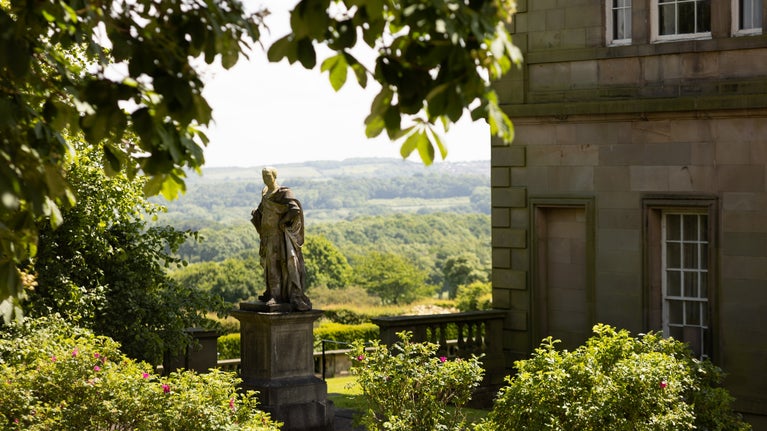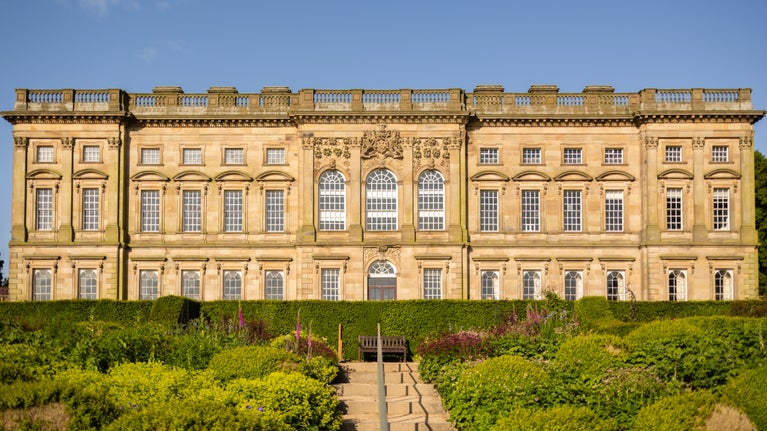
Discover more at Wentworth Castle Gardens
Find out when Wentworth Castle Garden is open, how to get here, things to see and do and more.

Wentworth Castle Gardens, near Barnsley was shaped in the early 18th century by Thomas Wentworth, 1st Earl of Strafford. His vision was refined by later generations who added to the grand house, gardens and parkland. After the Second World War, the house found a new purpose as an adult education college. The gardens and parkland were left to decay until the start of the 21st century, when a new heritage trust restored and opened the parkland.
There has been an estate at Stainborough near Barnsley for centuries. The estate was home to the Everingham family for almost 350 years. In 1610, they eventually sold the estate to another local family, the Cutlers.
The Cutlers were lawyers and local landowners. In the 1640s, they became active supporters of Charles I during the British Civil Wars. This left them with debts but did not stop Gervase Cutler II (c.1641–1705) rebuilding Stainborough Hall between 1669 and 1672. This strained the family finances further. In 1708, Thomas Wentworth (1672–1739) made a secret offer to Henry Cutler to buy the estate for £14,000.
Thomas Wentworth, 1st Earl of Strafford (2nd creation) was part of the extended family that owned nearby Wentworth Woodhouse. In 1695, he was aggrieved when Wentworth Woodhouse passed to a cousin and not him. As soon as he had money, he bought the nearby estate in an effort to establish a rival house and estate that would outshine his cousin’s. Over the years, he bought more land until his estate extended over the valley and right to the boundary of the Wentworth Woodhouse estate.
Thomas made his money after joining the army, rising to a senior post through a mix of good luck and personal bravery. Under Queen Anne, he became a diplomat. She made him an Earl in 1714, but his political influence ended when the Queen died that year. His rise was helped by a lucrative marriage in 1711 to Ann Johnson (1684–1754). Her father, Sir Henry Johnson (1661–1719), was a Member of Parliament and London ship builder who had made a fortune providing ships for global trading firms such as the East India Company.
Thomas consolidated his income and status by buying various estates across the country. Of these, Stainborough was by no means the largest or most valuable, but during the 1720s and 1730s, as a relative observed, he made it his ‘own monument’.
Most spectacularly, Thomas built a large new wing at a right angle to the modest existing Stainborough Hall, designing it to face east across the valley. Magnificent formal gardens and a grand parkland were carved out to surround the expanded house, featuring tree-lined avenues and extensive water features. On top of the hill, above the house and gardens, a mock ‘Stainborough Castle’ was created. He also renamed the house Wentworth Castle. The intended message was clear – this was now the centre of the Wentworth family.

Woven through the new Wentworth Castle house and parkland were political messages. Many reflect Thomas’s diplomatic role in helping to secure the Peace of Utrecht in 1713. This treaty ended the long War of the Spanish Succession and, amongst other prizes, saw Britain gain a monopoly to supply enslaved Africans to Spain’s colonies in the Americas. Thomas was an active (if not successful) investor in shares of the South Sea Company, the public-private partnership subsequently set up to run the monopoly.
In the early 1720s, Thomas bought a statue of a kneeling African man holding a sundial for the gardens. The statue survives at Wentworth Castle Gardens and may reference his involvement in helping Britain secure a much larger stake in the trade in enslaved Africans. It presents a challenging image to modern eyes and is a reminder of the role of slavery in Britain’s rising wealth and power during the 18 century.
When Thomas died at Wentworth Castle in 1739, his estates passed to his teenage son, William Wentworth, 2nd Earl of Strafford (1722–91). Unlike his father, William was not interested in a political career. Instead, he looked to consolidate his social place by demonstrating his refined taste, which he expressed though many changes at Wentworth Castle between the 1740s and 1770s.
These changes included the addition of a new wing to the house in the 1760s. Designed in the fashionable Palladian style, it emphasises symmetry, balance and classical form. In the parkland, the rigid formal tree lines were softened with new planting and the existing serpentine water feature, originally created for Thomas, was extended to appear more like a natural river. Several new structures were added across the estate, including a rotunda modelled on the ancient Roman temple of Vesta at Tivoli.

William left no children and a conflicting will, resulting in a series of legal struggles which lasted over fifty years. In 1803, Wentworth Castle eventually passed to the eight-year-old Frederick Vernon (1795–1885), who added Wentworth to his name. Wentworth Castle was considered a minor prize within the wider Wentworth estate, but rich coal reserves under Stainborough eventually made the Vernon Wentworths extremely wealthy.
This income helped fund further changes to the gardens, estate and house. In 1885, an extensive electrical lighting system, thought to be one of the first large-scale commercial installations in a private house, was commissioned. The lighting even extended to the conservatory, originally built in the mid-1870s. Today this conservatory is a lone survivor of several expensive glass and metal frame garden structures put up by the Vernon Wentworths. They used them to expand the range of what they could grow through the year and to display rare orchids and other tender, non-native plants.
By the early 20th century, the Vernon Wentworths spent relatively little time at Wentworth Castle and during the Second World War the house and parkland were requisitioned for military use. In 1948 the house, estate buildings and 60 acres of gardens and parkland were sold to Barnsley Council and repurposed as a college for a new generation of nursery and primary school teachers.
Changes to higher education funding in the 1970s led to the teaching college closing, but in 1978 it reopened as an adult residential college. Founded by the economist, social activist and educator Michael Barratt-Brown, Northern College continues to give adults from a broad range of social backgrounds new educational opportunities.
While Northern College undertook a limited program of garden restoration, a process of decay continued across the parkland. In 1966–8, the M1 motorway cut through the eastern parkland, while open cast mining in the 1940s and 1950s saw much woodland felled on the edges. Closer to the house, significant mining subsidence and neglect meant many features first created by Thomas and William had deteriorated or were lost.
The huge challenge to conserve the historic landscape and gardens and make them accessible to the public was taken on in 2002 by a new Wentworth Castle Gardens and Stainborough Park Trust. Significant support from the National Lottery and other funders saw the gardens and wider parkland reunited and opened to the public in 2007.
For the next decade the Trust continued its work. Struggling to remain financially viable, it was forced to close. Fortunately, a new partnership was forged between Barnsley Council, Northern College and the National Trust and the site re-opened in 2019. Today the work continues to conserve and develop the site for the people of Barnsley and its many visitors.
Adshead, David. ‘Stainborough Hall, South Yorkshire’, The Georgian Group Journal XXXII, 2024.
Eyres, Patrick (Ed.). ‘The Georgian Landscape of Wentworth Castle’, New Arcadian Journal 79/80, 2024.
‘Charlesworth, M. 'The Wentworths: Family & Political Rivalry in the English Landscape Garden' in Garden History, Vol. 14, No.2, 1986.

Find out when Wentworth Castle Garden is open, how to get here, things to see and do and more.
Discover the story of the woman commemorated by Wentworth Castle Gardens’ obelisk, which is among the oldest monuments in the UK dedicated to a woman based on personal achievements.

Discover how the property went from a power symbol built on the proceeds of slavery to an educational centre offering life-changing education to thousands of people.

We welcome groups of all types and sizes at Wentworth Castle Gardens, whether you’re a local community organisation, a school, a special interest group or part of a coach tour. Read on to discover how we can support your visit, then come and explore what makes this place so special.

Read our report on colonialism and historic slavery in the places and collections we care for and discover how we’re changing the way we approach these issues.

Learn about people from the past, discover remarkable works of art and brush up on your knowledge of architecture and gardens.
